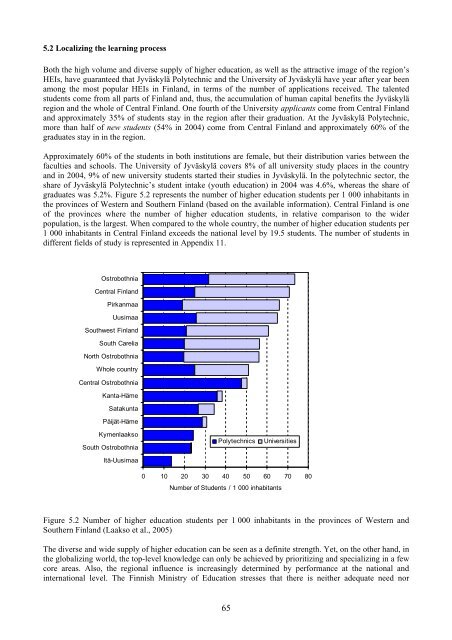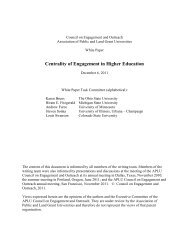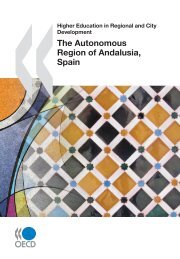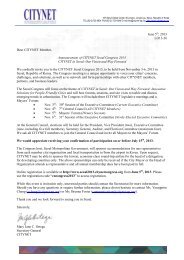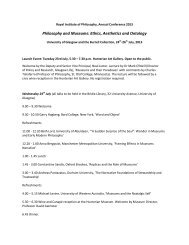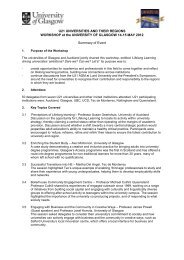5.2 Localizing the learning processBoth the high volume and diverse supply of higher education, as well as the attractive image of the region’sHEIs, have guaranteed that Jyväskylä Polytechnic and the University of Jyväskylä have year after year beenamong the most popular HEIs in <strong>Finland</strong>, in terms of the number of applications received. The talentedstudents come from all parts of <strong>Finland</strong> and, thus, the accumulation of human capital benefits the Jyväskyläregion and the whole of Central <strong>Finland</strong>. One fourth of the University applicants come from Central <strong>Finland</strong>and approximately 35% of students stay in the region after their graduation. At the Jyväskylä Polytechnic,more than half of new students (54% in 2004) come from Central <strong>Finland</strong> and approximately 60% of thegraduates stay in in the region.Approximately 60% of the students in both institutions are female, but their distribution varies between thefaculties and schools. The University of Jyväskylä covers 8% of all university study places in the countryand in 2004, 9% of new university students started their studies in Jyväskylä. In the polytechnic sector, theshare of Jyväskylä Polytechnic’s student intake (youth education) in 2004 was 4.6%, whereas the share ofgraduates was 5.2%. Figure 5.2 represents the number of higher education students per 1 000 inhabitants inthe provinces of Western and Southern <strong>Finland</strong> (based on the available information). Central <strong>Finland</strong> is oneof the provinces where the number of higher education students, in relative comparison to the widerpopulation, is the largest. When compared to the whole country, the number of higher education students per1 000 inhabitants in Central <strong>Finland</strong> exceeds the national level by 19.5 students. The number of students indifferent fields of study is represented in Appendix 11.OstrobothniaCentral <strong>Finland</strong>PirkanmaaUusimaaSouthwest <strong>Finland</strong>South CareliaNorth OstrobothniaWhole countryCentral OstrobothniaKanta-HämeSatakuntaPäijät-HämeKymenlaaksoSouth OstrobothniaItä-UusimaaPolytechnicsUniversities0 10 20 30 40 50 60 70 80Number of Students / 1 000 inhabitantsFigure 5.2 Number of higher education students per 1 000 inhabitants in the provinces of Western andSouthern <strong>Finland</strong> (Laakso et al., 2005)The diverse and wide supply of higher education can be seen as a definite strength. Yet, on the other hand, inthe globalizing world, the top-level knowledge can only be achieved by prioritizing and specializing in a fewcore areas. Also, the regional influence is increasingly determined by performance at the national andinternational level. The Finnish Ministry of Education stresses that there is neither adequate need nor65
esources to establish new activities, but instead only enough to get the existing activities and structuresworking effectively (see e.g., Ministry of Education, 2005b).By educating and training people to meet the needs of a more demanding and knowledge-based labourmarket, higher education institutions are vital in the process of upgrading regional skills. The learningprocess needs to encompass transversal skills (such as teamwork and entrepreneurial understanding) inaddition to specialist knowledge. The integration of graduates into the professional life of a region is achallenging task for the HEIs and regional actors. This might be supported by taking the regionaldevelopment aspect into account when planning the degree education modules and through the organizationof new, dynamic education programmes. Furthermore, in educating teachers, the increasing expectations ofthe surrounding society should be taken into account by strengthening their entrepreneurial thinking andexpertise in economic life.Education serving as a tool for labour market integrationThe results of the questionnaire indicate that the majority (75%) of the sample, taken from the University ofJyväskylä and Jyväskylä Polytechnic staff, thinks that the regional effects of HEIs are generated byeducation. Approximately half of the respondents agreed with the statement that meeting the needs of theregional labour force is emphasized in their operations. However, the degree of importance differsconsiderably between the university and polytechnic.The basic task for polytechnics is to serve the needs of the regional labour market. At the JyväskyläPolytechnic, the teaching is strongly tied to regional development and the needs arising from working life.Interplay with regional employers has been supported by the introduction of advisory councils in eachschool. These working-life oriented groups, consisting of representatives from firms and other organizations,participate in the content development of the study modules. The Jyväskylä Polytechnic also provideseducation in several other fields that are mainly oriented towards the national labour market (e.g., papermachine technology).The new polytechnic Master’s Degrees will educate new kinds of workers and experts who aim at enrichingstudents’ professional skills and expertise as well developing their working life. Master’s degrees are aimedat people who are employed (three years work experience is required after a higher education degree), andthe studies are organized so that they can be completed alongside the students’ work. These working-lifeoriented higher education programmes should be seen as a promising opening for both the region’s firms andthe students themselves. They provide an excellent opportunity for the polytechnics to further contribute totheir regional engagement. It is important to clarify to the regional employers in the very beginning what thebasic purpose of these new programmes is and how they differ from the university master’s degrees.Currently, the Jyväskylä Polytechnic offers master’s degree programmes in Health Promotion (20 students)and Technology Management (17 students), and in 2006 it will launch two new programmes in AutomationTechnology and Hospitality Management.At the University of Jyväskylä, the education of skilled workers for the national labour market as a whole isstrongly emphasized. For instance, the Faculty of Sport and Health Sciences is the only university levelinstitution in <strong>Finland</strong>, educating experts in the field of sport, and the Faculty of Humanities is the only oneproviding higher education in Art Education, thus they have a strong national mission. According to the data,at the University of Jyväskylä, the regional engagement of teaching largely depends on the faculties anddepartments in question. In some faculties, such as those of Information Technology and Sport and HealthSciences, the teaching is partly organized in cooperation with regional actors, with the aim of meeting theregional needs. The department of Teacher Education and Social Work within the department of Socialsciences and Philosophy, are also directed to working-life oriented teaching and the provision of a skilledlabour force, designed to meet the growing needs of the region. Rural areas as economic and social platformsis a special programme in the School of Business and Economics, which aims to closely integrate studentsinto the development of rural areas in Central <strong>Finland</strong> (e.g., through their graduation theses) (see Box 6.4 inChapter 6).Cooperation between HEIs, as well as their interplay with the other educational institutions, could improvethe possibilities for the provision of more regionally-oriented education. New modes of action, for example,66
- Page 1 and 2:
OECD/IMHE ‐ Supporting thecontrib
- Page 3 and 4:
SUMMARYTogether with 13 other regio
- Page 5 and 6:
8.2 Increasing the regional effecti
- Page 7 and 8:
I INTRODUCTION1.1 Strengthening the
- Page 9 and 10:
development. The aim is that region
- Page 11 and 12:
The self-evaluation considered here
- Page 13 and 14:
densely populated cities in Finland
- Page 15 and 16: 1,9 %1,7 %1,5 %1,3 %Population chan
- Page 17 and 18: The share of jobs in primary produc
- Page 19 and 20: New pillars of future’s developme
- Page 21 and 22: Jyväskylä0,60,91,11,0Central Finl
- Page 23 and 24: 2.4 Governance StructureMunicipalit
- Page 25 and 26: of its development outside the cent
- Page 27 and 28: III CHARACTERISTICS OF THE HIGHER E
- Page 29 and 30: continuing education and open unive
- Page 31 and 32: The Science and Technology Policy C
- Page 33 and 34: 3.2 Regional dimension within the n
- Page 35 and 36: order to respond to the challenges
- Page 37 and 38: 14001200Master's degreesDoctoratesN
- Page 39 and 40: 900800Youth graduatedAdult graduate
- Page 41 and 42: provide information for the basis o
- Page 43 and 44: CabinetParliamentSTPCSteering (andf
- Page 45 and 46: 5,04,0Billion euros3,02,01,00,083 8
- Page 47 and 48: The number of refereed articles is
- Page 49 and 50: Centre of expertisePaper industryBi
- Page 51 and 52: The Institute for Environmental Res
- Page 53 and 54: and systematic gradually progressin
- Page 55 and 56: are seen to be very important chann
- Page 57 and 58: Internal support units of HEIsThe F
- Page 59 and 60: of interviewed HEI staffs, the coop
- Page 61 and 62: areas of the region’s Centre of E
- Page 63 and 64: system of Jyväskylä and the HEIs
- Page 65: V CONTRIBUTION OF TEACHING AND LEAR
- Page 69 and 70: The main problem for the Finnish la
- Page 71 and 72: longer. 2.5% of the Jyväskylä Pol
- Page 73 and 74: activities. As a part of the new qu
- Page 75 and 76: education programmes consisting of
- Page 77 and 78: the TE-Centre of Central Finland an
- Page 79 and 80: practices in the provision of educa
- Page 81 and 82: Reason forskillupgradingDescription
- Page 83 and 84: Strengths+ HEIs are actively confro
- Page 85 and 86: taxation, to lower the unemployment
- Page 87 and 88: Box 6.2 The WIRE -projects: Support
- Page 89 and 90: indoor ice-skating rink, the Rauhal
- Page 91 and 92: The School of Cultural Studies at t
- Page 93 and 94: the number of registered customers
- Page 95 and 96: Box 6.9 Environmental management in
- Page 97 and 98: Strengths+ The significance of HEIs
- Page 99 and 100: eferring to the regional developmen
- Page 101 and 102: Key topics relating to changes in t
- Page 103 and 104: participation in the decision makin
- Page 105 and 106: in the strategy-making process. The
- Page 107 and 108: 7.5 Critical points in promoting th
- Page 109 and 110: 7.Cooperation in strategies concern
- Page 111 and 112: egion is according to national and
- Page 113 and 114: oundaries for further developmental
- Page 115 and 116: joining resources and operations by
- Page 117 and 118:
Discussion proposal 15: To ensure d
- Page 119 and 120:
achieved by the horizontal utilizat
- Page 121 and 122:
Appendix 2 Information on data used
- Page 123 and 124:
and finding synergy between the oth
- Page 125 and 126:
School of BusinessRoleThe School of
- Page 127 and 128:
The challenge of the school from re
- Page 129 and 130:
developing wellness and environment
- Page 131 and 132:
Faculty of EducationRoleThe Faculty
- Page 133 and 134:
and/or graduation thesis is a signi
- Page 135 and 136:
Areas of strength and prioritising
- Page 137 and 138:
Agora Center’s partners from the
- Page 139 and 140:
Currently the priority of ITRI’s
- Page 141 and 142:
Weak spots and areas to develop in
- Page 143 and 144:
Employment and Economic Development
- Page 145 and 146:
Appendix 3 Analysis of the most sig
- Page 147 and 148:
Appendix 4 Regional effects (input-
- Page 149 and 150:
The overall value of production cre
- Page 151 and 152:
Appendix 5 Reform of regional struc
- Page 153 and 154:
Appendix 7 Provision of education i
- Page 155 and 156:
Appendix 8 Statistical information
- Page 157 and 158:
Appendix 10 Statistics on financing
- Page 159 and 160:
Appendix 12 Labour market activity
- Page 161 and 162:
Appendix 14 Master’s Programmes a
- Page 163 and 164:
Uusiutuvan energian tutkimusohjelma
- Page 165 and 166:
BIBLIOGRAPHYAcademy of Finland (200


